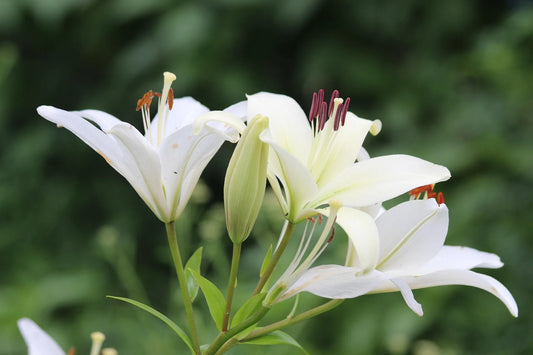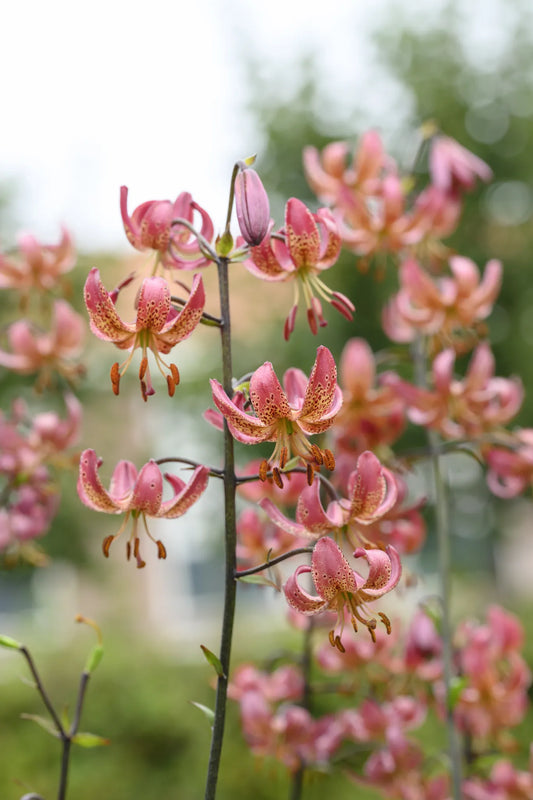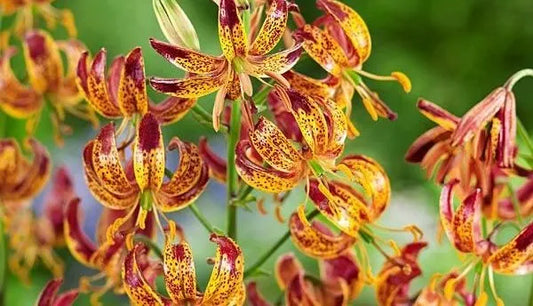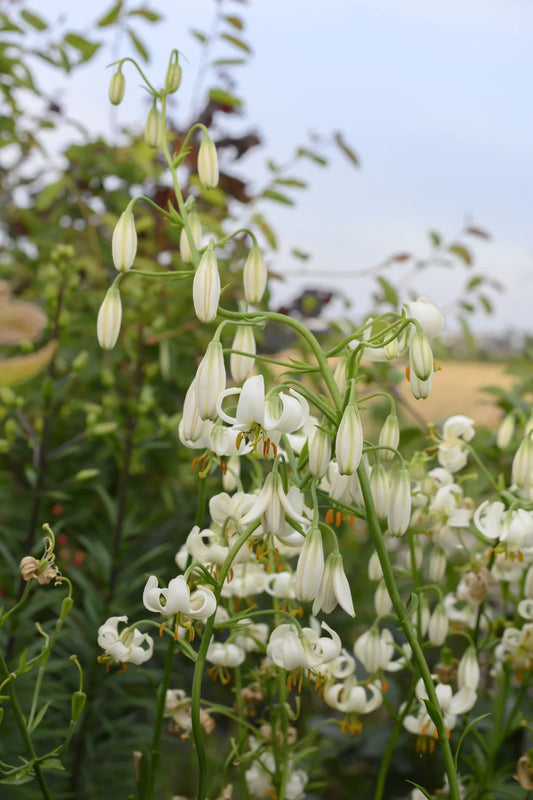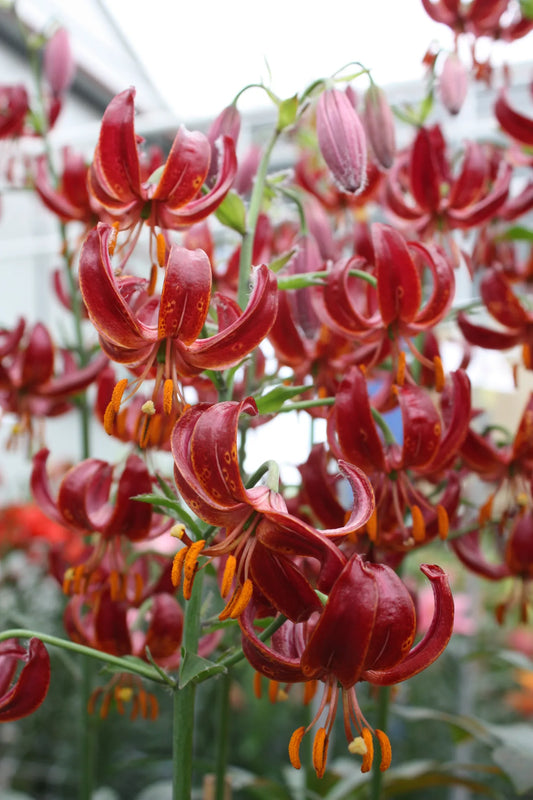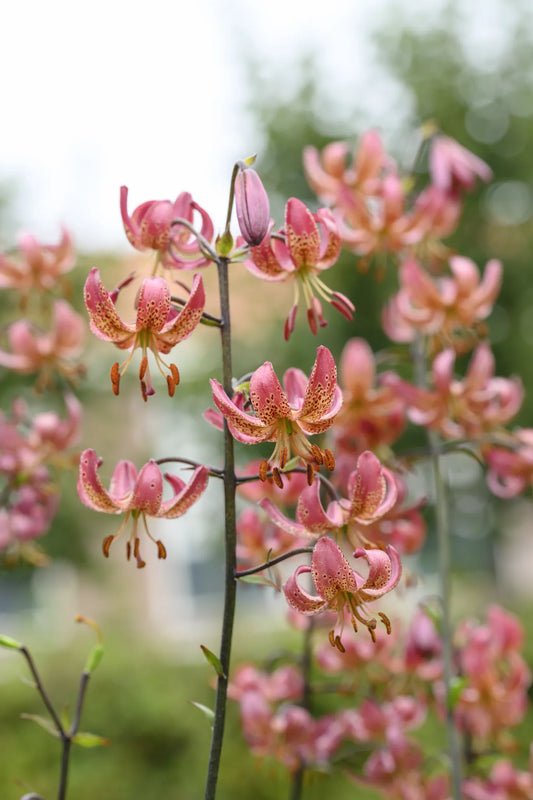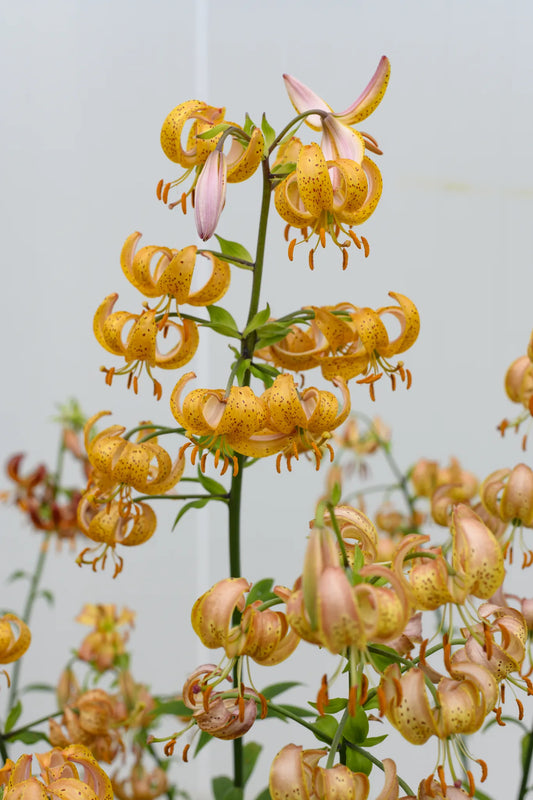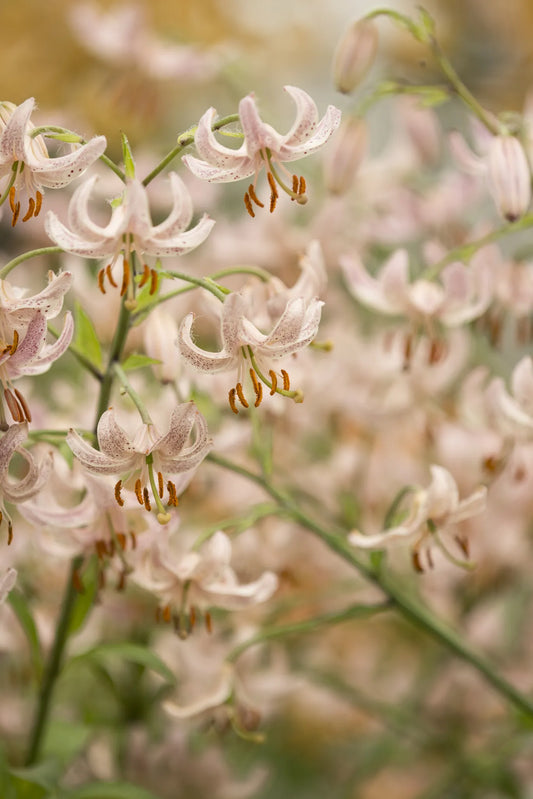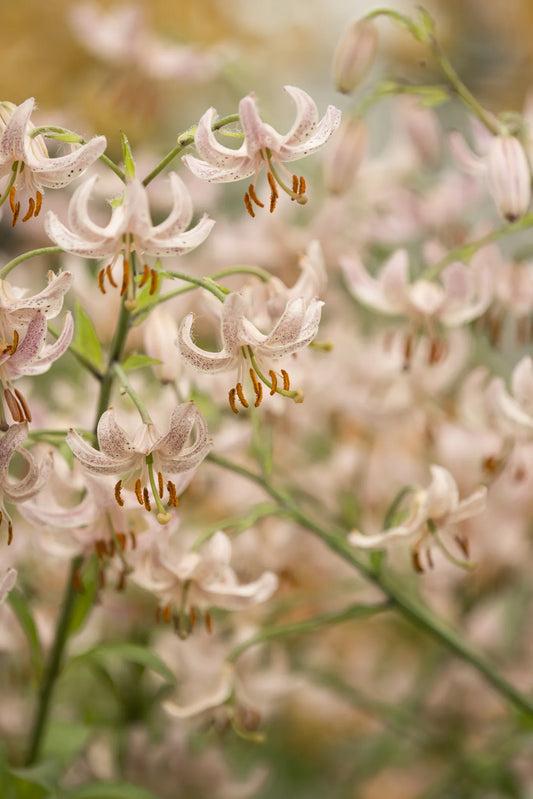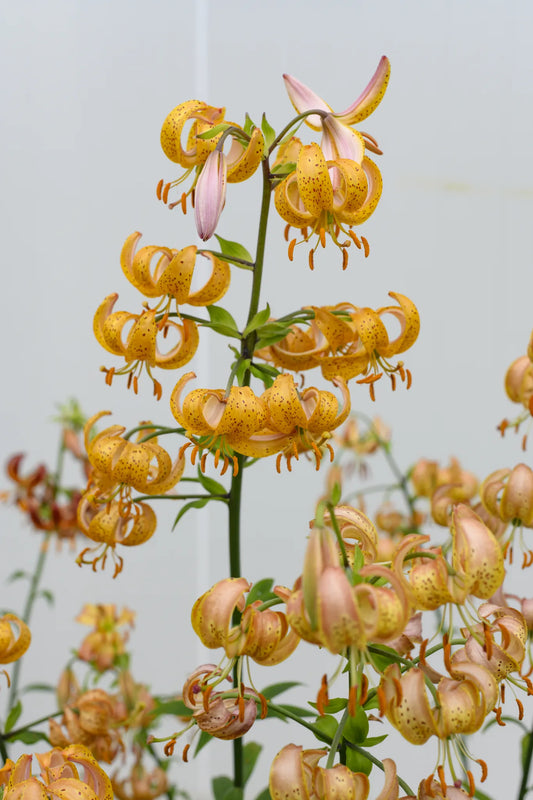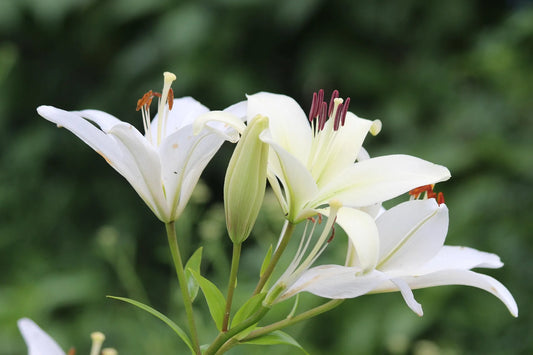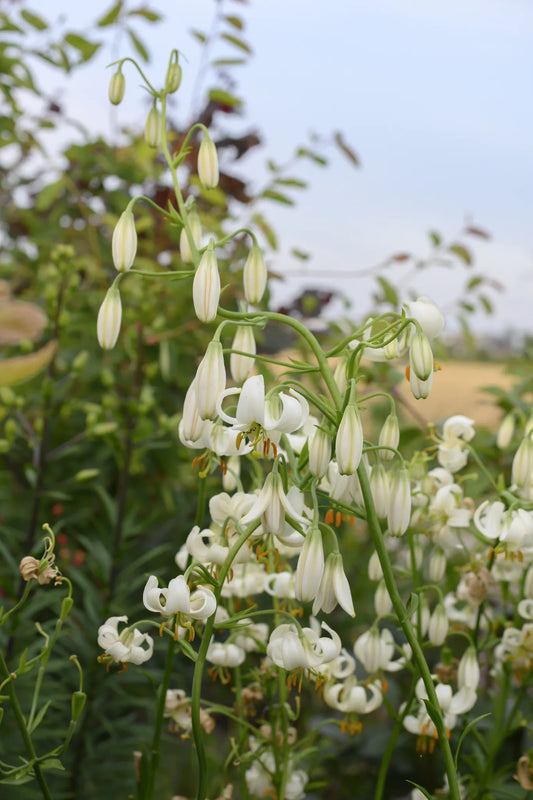Quality Lily Bulbs for Florists and Individuals
-
Livraison dès 10 bulbes France, Suisse et Europe
Modalité livraison -
Grossiste Bulbes de fleurs en ligne
-
Bulbes de Qualité
-
Paiement sécurisé
Virement / Chèques / Carte Bancaire / Chorus
-
Untreated flower bulbs Lilium candidum size 18/20 (4000510)
Regular price €2,85 EURRegular priceUnit price / per -
Untreated flower bulbs Lilium martagon Manitoba Morning size 12/+ (4005700)
Regular price €1,29 EURRegular priceUnit price / per -
Untreated flower bulbs Lilium martagon Arabian Knight size 12/+ (4005000) for individuals
Regular price €1,49 EURRegular priceUnit price / per -
Untreated Lilium martagon Snowy Morning® flower bulbs size 12/+ (4005300) for individuals
Regular price €1,49 EURRegular priceUnit price / per -
Untreated flower bulbs Lilium martagon Claude Shride size 12/+ (4008000) for individuals
Regular price €1,49 EURRegular priceUnit price / per -
Untreated Lilium martagon Manitoba Morning flower bulbs size 12/+ (4005700) for individuals
Regular price €1,49 EURRegular priceUnit price / per -
Untreated flower bulbs Lilium martagon Peppard Gold size 12/+ (4005600) for individuals
Regular price €1,49 EURRegular priceUnit price / per -
Untreated flower bulbs Lilium martagon Pink Morning size 12/+ (4009000) for individuals
Regular price €1,49 EURRegular priceUnit price / per -
Untreated flower bulbs Lilium martagon Pink Morning size 12/+ (4009000)
Regular price €1,29 EURRegular priceUnit price / per -
Untreated flower bulbs Lilium martagon Peppard Gold size 12/+ (4005600)
Regular price €1,29 EURRegular priceUnit price / per -
Untreated flower bulbs Lilium candidum size 18/20 (4000510) for individuals
Regular price €3,05 EURRegular priceUnit price / per -
Untreated flower bulbs Lilium martagon Snowy Morning® size 12/+ (4005300)
Regular price €1,29 EURRegular priceUnit price / per
Collection: Quality Lily Bulbs for Florists and Individuals
Quick read / the essentials about our Lilium Lily Bulbs
At Floriverse, a specialist wholesale supplier of flower bulbs , we offer a complete range of Lilium Lily Bulbs to meet the needs of professionals. Our lily bulbs, selected for their uniform size, vigor, and resistance, are available in conventional, untreated post-harvest, or certified organic varieties. This diversity meets the needs of floriculturists who care about quality and traceability.
Each batch comes from renowned specialist nurseries in Europe, guaranteeing optimal flowering, good vase life, and consistent growing behavior. Whether you're looking to buy Lilium lily bulbs for cutting, landscaping, or growing in pots, Floriverse offers reliable technical solutions and personalized support.
As a specialist wholesale supplier of flower bulbs , we ensure a smooth supply, efficient logistics and decreasing prices according to volumes. For your projects, large crops or recurring supplies, buying Lilium Lily Bulbs from Floriverse means trusting a specialist wholesale supplier of flower bulbs who understands the real needs of French producers.
Introducing our range of Lilies (Lily, Lilium)
Our wide range of Lily Flower Bulbs (Lily, Lilium) is specifically designed to meet the requirements of professional florists. At Floriverse, we provide Lily Flower Bulbs in three segments: conventional, untreated after harvest, and certified Organic , with full traceability. All our bulbs come from specialized nurseries recognized for their expertise, guaranteeing uniform flowering, optimal resistance and good behavior in cultivation. Our offer covers a diversity of varieties, colors and sizes, suitable for both cut flower circuits and landscaping.
Market approach: Lily (Lilium) cultivation in France
The French market for cut Lilium flowers is experiencing a contrasting dynamic: despite a strong dependence on imports (85% of the volume consumed), we are seeing a gradual revival of local production, particularly via new flower farms.
Lilium prices on the Rungis market between 2023 and 2025 show interesting stability, particularly for Oriental Liliums (between €28.00 and €33.00 for 10 extra stems), with peaks in value in winter and early spring. This stability encourages producers to invest in quality plant material.
The industry, historically concentrated, is diversifying. In Isère, for example, 12 flower farms were active in 2024, and several projects are underway. This confirms the emergence of a network of producers sensitive to the logic of short supply chains and differentiated quality.
At the same time, the demand for local production post-Covid is increasing, particularly among florists and organic networks. This context represents an opportunity for suppliers of organic or untreated Lilium bulbs, capable of offering traceable products, adapted to French climatic conditions and technical itineraries.
Our sales arguments for professionals
At Floriverse, we make agricultural supply simple and seamless for floriculture professionals. Our customers benefit from a responsive sales department , with a response and quote within 48 hours , and dedicated technical support throughout their growing cycle. Our lily flower bulbs at producer prices are delivered throughout France, with careful delivery within 15 days during peak season or reservations possible in advance.
We offer free, personalized quotes and technical advice tailored to each situation . Thanks to our comprehensive technical itinerary , our customers optimize their yield from the moment they plant. All our bulbs come from specialized nurseries , which guarantees professional quality and unbeatable value for money . Our platform allows the online sale of lily flower bulbs in bulk , with decreasing prices according to volume .
As a floriculture specialist , Floriverse supports farms in their development by providing them with reliability, visibility and quality throughout the purchasing chain.
Technical presentation of Lilium / Lilies / Lys: professional uses and potential in France
The cultivation of Lilium / Lilies / Lilies , commonly known as lilies, represents a significant opportunity for professionals in horticulture, green spaces and cut flowers in France. Known for their spectacular beauty and diversity, these perennial bulbous plants require precise technical knowledge to optimize their production and use. This detailed presentation aims to provide floriculturists, nurserymen, landscapers, community managers and private estate managers with the essential information to succeed with Lilium / Lilies / Lilies bulbs .
Botanical data and taxonomy applied to culture
The lily belongs to the genus Lilium / Lilies / Lilies , which includes about 100 species of perennial bulbous plants. The full scientific name used to designate the group is Lilium / Lilies / Lilies spp. when the species is not specified, such as Lilium / Lilies / Lilies candidum , Lilium / Lilies / Lilies regale or Lilium / Lilies / Lilies martagon . If a specific species is targeted, the proper name includes the initial of its descriptor, such as Lilium / Lilies / Lilies candidum L. . The botanical family of Lilium / Lilies / Lilies is Liliaceae . Lilium / Lilies / Lilies are distinguished from other bulbous plants sometimes called "lilies" but belonging to other families such as Amaryllidaceae (Easter lilies) or Hemerocallidaceae (daylilies). In a modern, restricted sense, the Liliaceae group together about 11 genera and 550 species, with Lilium / Lis / Lys as the type genus.
Natural origins and ecological preferences of species
Lilium / Lilies / Lilies are primarily native to the Northern Hemisphere, enjoying a very wide geographical distribution. They are found naturally in Europe, Asia (from Japan to India, Indochina and the Philippines), as well as in North America (from southern Canada to much of the United States). In France specifically, species such as Lilium / Lilies / Lilies bulbiferum (orange lily) are found naturally in the Jura, the Alps and Provence. Lilium / Lilies / Lilies adapt to a variety of natural habitats, mostly favoring humid forest environments, often in mountainous areas, but also more rarely meadows, open environments or even marshy areas. A few rare species in tropical Southeast Asia live as epiphytes (on other plants), while one species grows on rocks (epilyth). They generally prefer moderately acidic or lime-poor soils. These plants are adapted to temperate climates, extending into subtropical regions.
Morphology of the bulb: structural elements and practical implications
The Lilium / Lily / Lily bulb is a scaly bulb , sometimes called a "non-tunic bulb", because it does not have the protective covering (tunic) present in other bulbs such as the onion or the tulip. It is composed of fleshy scales imbricated around a flat base ( basal plate ) which gives rise to the roots. It is neither a corm nor a tuber, nor typically a rhizome, although some species propagate by short rhizomes. The scales are generally white to ivory, sometimes slightly pinkish depending on the variety. The dimensions of the bulb vary according to the commercial size and the species, generally ranging from 4 to 18 cm in circumference (e.g., size 12-14 cm for Asians, 16-18 cm for some hybrids). The scaly structure makes the bulb fragile and susceptible to desiccation and mechanical injury, so it is essential to handle these bulbs with care, avoiding separating the scales. Some Lilium / Lilies / Lilies , such as L. bulbiferum and its hybrids, also produce axillary bulbils (small black bulbs at the base of the leaves). Root development can occur from the base of the bulb and also on the underground stem (adventitious roots).
Morphological specificities of foliage
The foliage of Lilium / Lilies / Lilies is generally composed of elongated, lanceolate to linear leaves , characterized by a narrow, tapered shape and ending in a point. Their length varies according to the species; for example, in Lilium / Lilies / Lilies candidum , the basal leaves measure on average 15 to 20 cm long. The arrangement of the leaves on the stem can be alternate, whorled or spiral . The leaves are generally thin but firm, with a certain flexibility, and their surface is smooth and shiny, giving a glossy appearance, especially on adult leaves. The color of the foliage varies from medium to dark green, often with a notable shine. Some leaves may show red shades under the effect of cold , as in Lilium / Lilies / Lilies candidum . The foliage of the majority of Lilium / Lilies / Lilies is deciduous , drying and disappearing completely in autumn-winter. The notable exception is Lilium / Lily / Lys candidum , which keeps a persistent basal rosette during the winter, its cycle being reversed (foliage in winter, summer rest). As a general rule, the duration of effective foliage presence extends from emergence in spring (March-April) until flowering and the beginning of senescence (July to September), i.e. 4 to 6 months.
Floral typology: commercial aspects and diversity
Lilium / Lily / Lily flowers are highly valued by growers for their generous beauty and often strong fragrance. They are typically funnel-shaped, providing excellent visibility. The flowers can be large, necessitating staking of plants that can grow large. The exact size varies among varieties. Available colors are very diverse, including orange-red (such as Lilium / Lily / Lily bulbiferum ) and many other shades depending on the cultivar. Many varieties are highly fragrant, an important commercial attribute. Stems may bear multiple flowers, increasing their ornamental value. The exact number varies; the martagon lily , for example, may bear up to 50 flowers on a single stem. The flowers are composed of six tepals (three petals and three sepals of similar appearance). The flowering period generally extends from May to October, providing a long commercial season . To encourage continued flowering, it is recommended to regularly cut off faded flowers .
Height and shape of stems at maturity according to groups
The mature height of Lilium / Lilies / Lilies varies considerably depending on the species and variety, but for professional use, the ranges observed on the French market are relevant. Oriental Lilium / Lilies / Lilies reach around 60 cm, Lilium / Lilies / Lilies martagon up to 1.50 m, Lilium / Lilies / Lilies auratum up to 1.60 m, and Lilium / Lilies / Lilies candidum 1.20 m on average. Other varieties can exceed 2 m in optimal conditions. Most varieties grown professionally for cut flowers or in beds are therefore between 60 cm and 1.60 m. The general habit of Lilium / Lilies / Lilies is upright (straight), which is well suited to the production of cut flowers or for growing in professional beds. A few exceptions exist, but the majority have an upright habit.
Flowering window: period, duration and influence of cultural practices
Lilium / Lilies / Lilies bloom mainly from June to August. However, depending on the variety, it can start as early as May-June and continue until September. This amplitude allows for staggered production . The flowers bloom sequentially on the same flower stem, thus extending the natural flowering period. Individual flowers measure between 2 and 20 cm in diameter, reaching up to 30 cm for some varieties. The planting period influences flowering: autumn planting in mild regions allows normal flowering from the first year, while spring planting in cold regions slightly delays flowering. Exposure in partial shade ("cold feet") is also important.
Hardiness levels by species and USDA zones
The hardiness of Lilium / Lily / Lily bulbs varies depending on the species and hybrids, but most professionally grown Lilium / Lily / Lily are hardy to about -20 °C to -25 °C , corresponding to USDA zones 5 to 6 . Some hardier botanical species, such as Lilium / Lily / Lily martagon or Lilium / Lily / Lily lancifolium , can tolerate temperatures close to -30 °C ( USDA zone 4 ). In metropolitan France, growing zones are mostly between zones 6 and 8 ( -23 °C to -6.7 °C ), which makes most horticultural Lilium / Lily / Lily suitable .
Biological cycle and sustainability of the bulbs in place
Lilium / Lily / Lily is a perennial bulbous plant. Its annual life cycle begins in spring with the growth of young stems, followed by flowering in summer. After flowering, the majority of Lilium / Lily / Lily plants are deciduous , losing their foliage for the winter and entering dormancy. Lilium / Lily / Lily candidum is an exception, retaining its basal rosette of leaves in winter and entering summer rest. The plant emerges from a scaly bulb without a tunic , vulnerable to drying out. This bulb allows the storage of nutrient reserves. Bulbs are generally planted deeply , except for Lilium / Lily / Lily candidum . A technical peculiarity is the possible production of cauline roots on the stem, above the bulb, which help to anchor the plant. Lilium / Lily / Lily plants are generally very hardy (down to -20°C), although young shoots can be sensitive to late frosts . As a perennial, a Lilium / Lily / Lily can live for several years in the same location if conditions are favorable. Planting is usually done in the fall or early spring.
Vegetative propagation methods for renewal
Lilium / Lilies / Lilies are propagated primarily by asexual methods. Bulb division is the simplest method, consisting of digging up dense clumps in late summer/early autumn, separating the bulbs and replanting them immediately. Scaling is an effective technique for rapid propagation: taking scales from the mother bulb (along with a piece of the basal plate), treating, placing in a warm, moist environment, then refrigerating before planting. Bulbils form at the base of the scales. Some varieties, such as tiger lilies ( Lilium / Lilies / Lilies lancifolium ), naturally produce axillary bulbils in the leaf axils in mid-summer. These bulbils can be harvested and cultivated. In terms of speed, chipping can produce 3-5 bulbils per scale, with 20-30 scales per bulb, reaching marketable size in 1-2 years. Division can double or triple the stock annually. Axillary bulbils can mature in about 1 year. Chipping offers the greatest yield in numbers per parent bulb, but requires more care.
Major horticultural groups and reference varieties for the sector
For professionals in France, it is relevant to distinguish several main groups of Lilium / Lilies / Lilies and notable cultivars . Asiatic Lilium / Lilies / Lilies are hardy and easy to grow, with abundant flowering. Oriental Lilium / Lilies / Lilies are renowned for their spectacular and highly fragrant flowers, generally larger than Asiatic Lilium / Lilies / Lilies. Oriental Trumpet (OT) Lilium / Lilies / Lilies combine these characteristics with good resistance. Popular commercial series include 'Beau Monde', 'Come Back', 'Explosion', 'Lefeber's Memory', 'Pink Impression', 'Purple World' and 'Spryng', as well as the varieties 'Fusarino' and 'Furand'. Lilium / Lilies / Lilies candidum (White Lily) is of particular interest to the French market. It grows to over 1 meter, is very robust, glabrous, with leaves spread at the base and erect on the stem. Its flowering extends from May to July, producing very large, pure white flowers, very fragrant (sweet smell), arranged in a loose cluster (3 to 10 flowers per stem). Its very open bell-shaped flowers have oblong divisions arching outwards. It is cultivated throughout France, subspontaneous in certain Mediterranean regions, and native to Lebanon. Other botanical species can enrich a professional catalog.
Toxicity: regulatory aspects and signage in production
Lilium / Lilies / Lilies have important particularities to be aware of, particularly in terms of toxicity . For cats , Lilium / Lilies / Lilies (genera Lilium / Lilies / Lilies and Hemerocallis ) are extremely toxic. Ingestion of any part of the plant (flowers, leaves, stems, pollen, vase water) can cause acute kidney failure, which is potentially fatal. Studies show that 5% of exposed cats developed long-term kidney failure and 5% had to be euthanized despite prompt care. In dogs , toxicity is moderate, mainly causing digestive disorders (vomiting, diarrhea), rarely severe kidney damage. For humans and livestock , cases of serious poisoning are rare, with a moderate digestive risk for children in case of ingestion. There is no particular risk to the safety of professional growers when handling. Regarding protected status , commercial horticultural varieties are generally not protected, although some native wild species may be locally protected. For marketing, clear signage on toxicity to cats is strongly recommended.
Cut flower behavior: yield and points of vigilance
Lilium / Lilies / Lily is a plant of choice for cut flowers , representing about 70% of this production for scale bulbs. Among the types marketed are Lilium / Lilies / Asiatic Lilies ('Enchantment', 'Connecticut King', 'Mont Blanc'), Lilium / Lilies / Oriental Lilies (derived from L. auratum and L. speciosum ), and Lilium / Lilies / Longiflorum . Technical advantages include stem quality and yield, which are strongly influenced by bulb size. Recommended minimum sizes are 12/14 for longiflorum , speciosum and Asiatic, and 14/16 for Orientals. Vase life is excellent if the stems are cut at the colored bud stage (about 2 days before opening), ideally in the morning. The addition of a preservative prolongs shelf life. The fragrance , particularly intense in Lilium / Lilies / Oriental Lilies , is a sought-after asset. Limitations include environmental sensitivity (avoid direct sunlight, drafts, heat) and the need to renew the bulbs every 3-4 years to maintain production. Cultivation can be carried out all year round with proper planning. For best preservation, cut the stems diagonally with a clean knife and remove the lower leaves.
Professional landscaping: integration methods and advice
Lilium / Lilies / Lilies integrate very well into various landscapes thanks to their diversity and growth habit. In clumps , giant varieties provide height and structure, creating a focal point. Planted in groups, such as Lilium / Lilies / Lilies brownii var. viridulum , they add visual interest. In borders , their slender stems take up little ground space, allowing smaller plants to be combined for a layered effect. Some species, such as Lilium / Lilies / Lilies martagon, thrive in shady situations (light shade under a tree or in a clump of perennials). Compact varieties can be grown in containers on terraces or in limited urban spaces. Technical requirements include a specific planting depth (e.g., 10-12 cm for L. martagon ) and adequate spacing for visual effect and air circulation. Most require a sunny position with the base in the shade, or a lightly shaded location.
Naturalization capacity: species adapted to the French climate
Some species, such as Lilium / Lilies / Martagon Lily , demonstrate excellent naturalization capacity once established. Left in place, they develop by gradually forming several stems. Their hardiness ensures their longevity in France, even in harsh winters. Over the years, a single bulb can form an imposing clump that fits well into natural or semi-natural arrangements. Unlike other varieties, L. martagon , Henryi Lily and Madonna Lily tolerate calcareous soils well, increasing their naturalization potential in various regions. For successful naturalization, it is crucial to choose species adapted to local conditions and to provide a draining soil enriched with organic matter .
Technical interest for public spaces and communities
Lilium / Lilies / Lilies , particularly Asiatic lilies, are well suited to public and community green spaces due to their robustness and ease of cultivation. These characteristics meet the needs of minimal maintenance and maximum visual impact . Technical advantages for communities include their resistance and adaptability to various French climatic conditions, reducing the replacement rate. The spectacular flowering , potentially long-lasting for double-flowering varieties, maximizes the decorative value. Maintenance is reduced compared to other ornamental species. Key technical data: average lifespan of 3 to 5 years , recommended density of 7 to 10 bulbs/m² , planting depth of 10-15 cm , height of 60-120 cm , moderate water consumption after establishment , and reduced annual maintenance cost (around €2.5/m² compared to €5-8/m² for classic annuals). The staggered flowering by type (Asians: 2-3 weeks in June-July; Orientals: 3-4 weeks in July-August; modern hybrids: up to 6 weeks) is an asset for maintaining summer attractiveness.
Pollen attractiveness: ecological role and opportunities
Lilium species attract pollinators , although attractiveness varies depending on the species, floral morphology, and flowering period. Trumpet-flowered Liliums are adapted to pollination by moths (hawkmoths). Species with open, fragrant flowers, such as Lilium candidum , also attract bees, bumblebees , and sometimes beetles . Martagon Lilium is visited by bees and butterflies . Technically, a tiger lily ( Lilium lancifolium ) plant can bear up to 30 flowers per stem , increasing opportunities. Fragrant lilies produce significant nectar and pollen , attracting pollinators during their peak flowering period (June to August). The period of attraction extends from early June to September, depending on the species/cultivar.
Plant associations: landscape enhancement and cultural compatibility
Combining Lilium / Lilies / Lilies with other plants is aesthetically and culturally beneficial. For aesthetic effects , combine perennials with decorative foliage (hostas, perennial geraniums, ferns) for a contrast of textures and volumes. Partial shade plants (astilbes, heucheras, foxgloves) create an undergrowth effect and prolong the visual interest. Ornamental grasses (Stipa tenuissima, Pennisetum) bring lightness. For complementary crop associations , the Iridaceae and Amaryllidaceae families share similar drainage and hardiness requirements. Alliums (ornamental garlic) are known for their repellent properties against certain pests (aphids, mites). Crop rotation and association with plants that are not very susceptible to fungal diseases (botrytis, fuzariosis) are recommended. Technically, a spacing of 20 to 30 cm between lily bulbs , and 30 to 40 cm between companion perennials is recommended to limit root competition. Associate the lily with plants with similar water requirements .
Post-flowering phase: technical management of foliage
The ornamental interest of Lilium / Lilies / Lilies after flowering is mainly limited to their foliage , although this is not generally considered particularly decorative. The foliage, composed of elongated, lanceolate to linear , dark green and glossy leaves, arranged alternately, whorled or spirally, plays a crucial physiological role after flowering: it allows the bulb to recharge its nutrient reserves via photosynthesis . For this reason, it is technically recommended not to cut the leaves immediately after flowering, but to wait until they turn yellow naturally . This phase is decisive for the quality of the following year's flowering . Lilium / Lilies / Lilies candidum is an exception in retaining its persistent basal rosette in winter, offering specific ornamental interest during this period. For professionals, it is essential to manage this period properly by removing only faded flowers , keeping the stem and leaves until they naturally yellow, and monitoring pests (lily leaf beetle) that affect the foliage.
Yield of commercial stems per square meter
In professional cultivation of Lilium / Lilies / Lily in France, the average expected yield is technically based on planting density and production per bulb. The optimal density is around 9 bulbs per square meter for varieties like Lilium / Lilies / Lys speciosum 'Rubrum', although this can vary slightly depending on the variety and the desired stem size. Generally, each bulb produces one commercial flower stem (a flower scape) during the first year of cultivation. In very favorable conditions, a mature bulb can sometimes produce 2 stems. With a density of 9 bulbs/m², the standard yield is therefore 9 commercial flower stems per square meter for a harvest. In intensive cultivation with optimal agronomic management , this figure can reach 10 to 12 stems/m² . Asian, Oriental and Lilium / Lilies / Lys longiflorum hybrids are the most widely used as cut flowers, with comparable productivity per bulb. Lilium / Lily / Lilies tigrinum can bear more flowers per stem (up to 10–20) but this does not affect the yield in number of stems/m². Well-drained, rich, humus-rich soil , as well as adequate exposure , are essential for optimum yield.
Operational synthesis: strategic positioning in professional floriculture
In summary, Lilium / Lily / Lily is a perennial bulbous plant with specific but well-controlled technical requirements , offering strong potential for professional production in France, whether for cut flowers , landscaping or public spaces . A thorough knowledge of its botanical characteristics , its precise cultural needs , its sensitivity to diseases and pests, as well as propagation and post-flowering management techniques, will allow professionals to optimize their production and offer high-quality products .
To summarize: Our Lilium Lily Bulbs
Choosing Floriverse to buy Lilium Lily Bulbs means trusting a specialist wholesale supplier of flower bulbs committed to French producers. Our lily bulbs cover all professional needs, whether Asian, Oriental, or botanical varieties, and are suitable for both outdoor cultivation and the production of high-end cut flowers.
With rigorous horticultural quality standards (size, consistency, traceability), you can purchase certified organic, untreated, or conventional Lilium lily bulbs , depending on your production strategy. Floriverse guarantees fast delivery, personalized technical advice, and professional support every step of the way.
Whether for your local markets, short circuits or call production, buying Lilium Lily Bulbs from Floriverse means ensuring excellent value for money from a wholesale supplier specializing in flower bulbs . Trust our professional expertise, our network of specialized nurseries, and our commitment to more sustainable French floriculture. Floriverse remains your reference partner, a wholesale supplier specializing in flower bulbs , to support you in the success of each campaign.
-
-
Wholesale Flower Bulbs Online
We work with dozens of producers to offer you the best prices for your flower bulbs.
-
Quality Bulbs
Our producers are selected for their reliability and the quality of their bulbs.
-
Your bulbs at the best prices
We work every year with your partner producers to offer you the best prices

